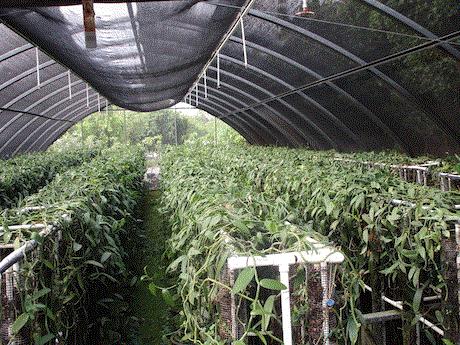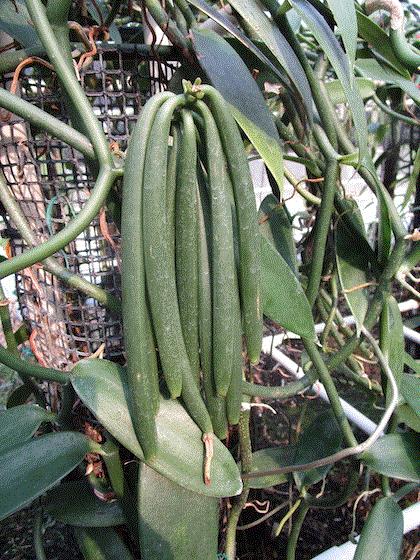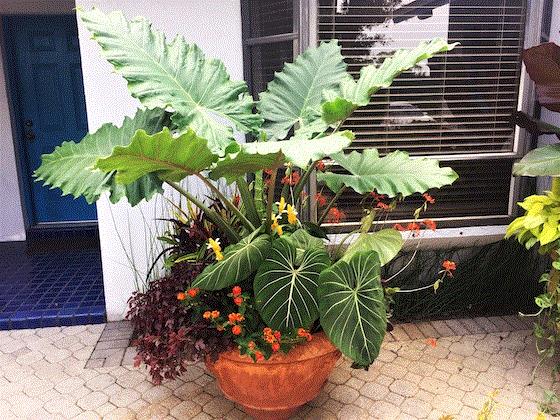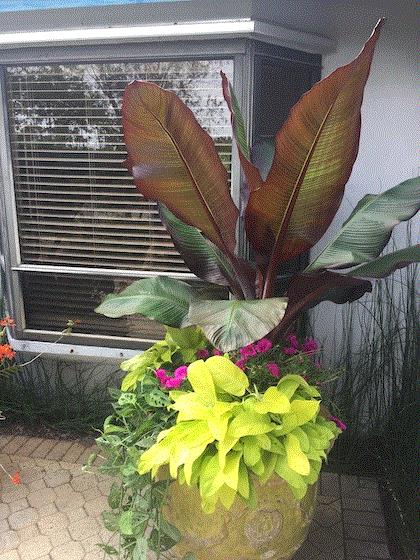About That Vanilla
In response to my piece about possible vanilla production taking place in South Florida rather than having it imported from Madagascar, Mexico and the like, I was informed that vanilla production is already happening in the States, thankyouverymuch. Richard Criley sent me that news/not news along with a few photos of some vanilla orchid production houses.


Glamorous orchid growing, it is not. Couple that with the fact that in order to give birth to the baby bean pods each orchid must be pollinated by hand (because this orchid’s natural pollinator doesn’t exist in Hawaii), vanilla production becomes a tad bit more labor intensive. Richard said folks at this particular facility use stilts to reach the uppermost flowers. HERE IS A VIDEO I pulled off of Allan Chambers’ website—he’s the UF vanilla researcher I mentioned last time. Fascinating plant nerd stuff!

I did a little online research and found the following about Hawaiian production of vanilla:
-
Vanilla production takes just ¼ of the land to produce a profitable crop compared to coffee.
-
Vanilla production areas are called vineyards.
-
Cuttings can take one to four years to produce flowers.
-
The vanilla flowers—which bloom anywhere from February to May in Hawaii—are open for just four hours. That’s a pretty tight window for hand pollination!
-
The bean grows up to another six months before being ready for harvest.
-
Harvested pods are blanched and sun dried for two to three months.
-
Start to finish, it takes about five years to produce one vanilla bean pod.
-
Of the spices, only saffron is more expensive than vanilla.
-
The vanilla orchid is native to Central America (tropical Mexico) and is pollinated by the local Milipona bee.
From what I can figure out, there are five vanilla bean producers in Hawaii. Is there room in the U.S. market for another production region? Allan Chambers would be the one to ask and I’m hazarding a guess he'll say yes. I would say if there’s room for olive growers in California, tea in the Carolinas and locally produced hops grown everywhere, then I say viva la vanilla.
Breaking: I just spotted this article about the dark underbelly of the vanilla market in The Economist: "Vanilla Fever: How did hunger for the humble vanilla pod lead to greed, crime and riches?" Maybe that's another good reason to grow the crop stateside.

Kilauea One Year Later
I'd been in touch with Richard just a few days previously, as I'd been reminded of the one year anniversary of the start of the Kilauea volcano eruption. More than 700 homes were destroyed over, I believe, a four-month eruption period. Once rich, fertile land is now covered in rock—up to 80 ft. in some places. And if homes and businesses weren’t outright destroyed, then access to them was cut off by lava flows or they were (and still are) impacted by toxic fumes. Volcano damage makes tornado recovery look tame.
Farming is slowly coming back to the area hit by the volcano. An ARTICE looking back at the region’s one year of recovery tells how three farmers have made do and adjusted to what is now their new normal. A survey by the University of Hawaii College of Tropical Agriculture and Human Resources found that nearly 90% of farmers who suffered losses were willing to start over. That’s some sticktoitiveness, considering that a Hawaii County preliminary damage assessment found that ag businesses had lost about $23 million. Continuing on from near or complete ruin? Gutsy. Confident.
As we’ve seen from the above piece (or know from experience), it’ll take a long time to reestablish the island’s orchid industry. And with the average age of Hawaiian farmers being 60 (as determined in 2017), starting from square one for many folks may look like too much of a long-term investment. We’ll see what's unfolded at the second anniversary of the eruption.

David’s Tropical Containers
A few weeks ago, I asked for suggestions for plants that would do well in an outdoor room, and considering this crowd is tropical-savvy, I was hoping for a bunch of suggestions with tropical flair.
That's exactly what I received from David Bache of Garden Industries. His suggestion? Large containers of mixed tropicals in pottery, terracotta or miscellaneous found objects, such as barrels and old metal containers.
“Continuing with the current trend for large leafy houseplants, why not use Monstera deliciosa, musa or larger philodendrons (P. giganteum, Evansii, P. gloriosum) to create a very tropical feel? They can be underplanted with other cascading plants (small philodendrons, pileas, pothos or various tradescantia) or mixed with colorful annuals. Palms are also a good choice to create the right vibe. Other tropicals such as cordylines, crotons, small heliconia or ginger add plenty of color. Many of these plants can be brought indoors during the winter in more temperate areas and used year after year.”
David not only suggested, he acted! He got to work and potted up a few tropical pots:

Alocasia Portodora, Philodendron gloriosum, Hibiscus acetosella, Dallas Red Lantana, Epidendrum ibaguense, Pachystachys lutea, Congo Codiaeum variegatum and Tradescantia zebrina

Maurelii Ensete ventricosum, Lemon Lime Philodendron, Monstera adansonii, Samba Purple Portulaca
Nice, huh? If you have tropical combos that would look great in an outdoor room, I’d love to see them—and then share your combo container talent with my garden retailer friends in my Buzz e-newsletter. You know, get them inspired for July sales—and maybe inspire them to buy your stuff. Send your pics to ewells@ballpublishing.com.

Shortages?
I’ve received a report that there are some tropical and houseplant shortages out there. I’m wondering if you’re having the same experience with these four crops—or perhaps this individual is alone in his dilemma. The four crops are:
Ponytail palm. I believe this is both seed and smaller sizes of plants (stumps, actually). Who has seed? Who needs seed? What’s your stump situation?
Majesty palm. Again, seed shortages, which are leading to liner shortages. There are alternatives to majesty palm that can fill in. Can anyone fill us in on what’s going on with seed and general supply?
Monstera deliciosa. Shortages, you know, because Instagram. How’s supply? Who has it and who wants it? Who’s got seed?
Pothos. I almost spit out my coffee when I read this person’s email saying he was having trouble sourcing pothos. I guess it’s the case of the supply was ready before demand, and when those crops didn’t sell, growers scaled down production. Now that demand is sky high, there’s not enough to go around. He reported that buyers are taking plants that barely have roots and haven’t filled out, such is their desperation for having something—anything—to sell. Any secret sources out there? I’ll do my part by snapping off a few vines and sticking them in a glass of water.
If you any information to share about these purported shortages, drop me a line HERE.
Speaking of Monsteras
If you have two or three split-leafed monsteras in the 4- to 5-ft. tall range, I’ve got a credit card and shipping address for you. Or a fiddle-leaf fig. I’m looking for something tall and space-filling for corners of a couple of rooms. It’ll be a pleasure doing business with you! Drop me a line at ewells@ballpublishing.com.
Suggestions, comments, questions or news to share? Just drop me a line at ewells@ballpublishing.com.

Ellen Wells
Editor-at-Large
Green Profit
This edition of Tropical Topics was sent to 27,638 loyal readers!
If you're interested in advertising on Tropical Topics, contact Kim Brown ASAP!